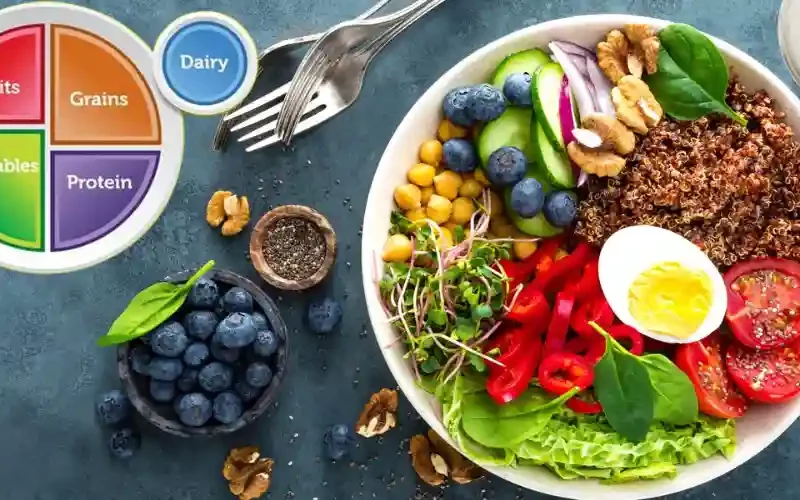Healthy foods and a balanced diet can help you stay at a normal weight, reduce your risk for certain diseases, and boost your mood. But with all the nutrition and dieting advice out there, it can be difficult to know what to eat.
Read the Nutrition Facts label and ingredients to avoid added sugars (which can hide in foods such as flavored coffees, teas, sodas, and milkshakes) and saturated fats.
1. Nutritional Value
The nutritional value of food refers to how much protein, carbohydrates, fat and vitamins it has. This information is available on the Nutrition Facts label, which can help you make healthier choices.
The best choice is a diet rich in vegetables, low-fat or fat-free dairy products and whole grains. Limit foods that are high in added sugars, such as candy, cookies and cake, and beverages with empty calories, like sodas and energy drinks.
Remember that the nutrient amounts listed on the labels are for one serving size.
2. Cost
Many people who choose unhealthy foods are trying to save money, but it may end up costing them more in the long run. Unhealthy diets can lead to health problems that are expensive to treat, such as heart disease, diabetes and cancer.
In a study, Harvard researchers looked at 27 existing studies that included price data for healthy and unhealthy foods or diets. They examined prices per serving or per 200 calories for individual food items and per 2,000-calorie samples for overall diet patterns. They found that healthier choices cost about $1.50 more a day, on average.
3. Taste
A common gripe people have when trying to eat healthier is that healthy food tastes bland. This is due to the fact that most processed foods contain a lot of sugar, salt and artificial flavors, which dulls your taste buds.
Adding flavor to healthy foods can help make them more appealing. Studies have shown that labeling vegetables with taste-focused names like “twisted citrus glazed carrots” can get diners to eat more of them than they would otherwise. (36)…and if you add spices to these meals, they can also become more delicious.
4. Environment
Researchers have found that healthy foods are almost always good for the environment, and unhealthy ones harm both people and planet. They compared the environmental harm (from greenhouse gases to water use and pollution) of eating various food types, finding that plant-based foods – like fruit, vegetables, legumes and whole grains – did the least harm and were best for health; unprocessed red meat had the worst impact. Processed foods high in sugar had a lower impact but were still bad for health. The results could help consumers, policy makers and food companies make better choices.
5. Convenience
Convenience refers to procedures, products or services that make food easier to access and prepare. It is a relative concept that depends on context.
The use of convenience foods may be beneficial if they are inexpensive and associated with positive images and meanings. However, some participants in the study linked convenience food with unhealthy ingredients and derogatory effects on health. Moreover, many adolescents reported using convenience food to save time. This suggests that the development of competences is an important aspect to consider.
6. Personal preference
If a person loves the taste of ice cream or potato chips, they should be allowed to have them on occasion. But they should find a way to balance these foods with other healthy options, such as lean red meat, whole grains, vegetables and fruits.
It is important to read food labels to look for ingredients such as sodium, sugar, artificial sweeteners, and preservatives. Also, make sure to choose foods from the MyPyramid guidelines, while limiting unhealthy foods like fried foods and snacks. This will help people achieve their best health.
7. Culture
Many cultures have specific dietary guidelines that may impact healthy food choices. For instance, religion may dictate dietary restrictions like the consumption of beef or pork. Socioeconomic status can also influence affordability and access to healthy foods.
Cultural communities can also provide a sense of support and accountability that helps individuals develop healthier eating habits. This can include providing a variety of nutritious foods, cooking classes, and other activities that celebrate culture while supporting healthy choices. This can be accomplished by offering food bars to allow customers to build meals with a mix of their cultural preferences and nutrient-packed options.
8. Healthiness
Eating healthy includes getting a range of nutrients. It also means limiting sodium, sugars and saturated fats. This helps reduce your risk of health problems like heart disease and some cancers.
You can find a variety of healthy foods at most supermarkets and stores. Read the Nutrition Facts label to check for added sugars and unhealthy fats. A healthy diet provides the energy you need to keep active throughout the day and supports good mental health. It can also help reduce your risk of certain diseases and prevent obesity.
9. Affordability
One of the biggest barriers to a healthy diet is that it can be expensive. But there are ways to save money while shopping for nutrient-rich foods.
Start by cutting out junk food like soda, cookies, chips and prepackaged meals. Then focus on purchasing fresh, local produce when it is in season-this will be cheaper and tastier than buying produce out of season.
Also, look for store-brand items, which are usually cheaper than name brands. Finally, don’t shop on an empty stomach-this will lead to unhealthy impulse buys.
10. Sustainability
Sustainability is a factor that should be considered when choosing healthy foods. Sustainable eating involves minimizing the environmental impact of our food choices. This includes reducing meat consumption, avoiding ultra-processed foods and beverages, and purchasing from local farmers.
It also includes limiting ocean seafood consumption to avoid overfishing and respecting natural habitats. Buying seafood marked with a sustainability label is one way to do this. In addition, using reusable grocery bags helps to reduce waste. These small changes can make a big difference in the world.







